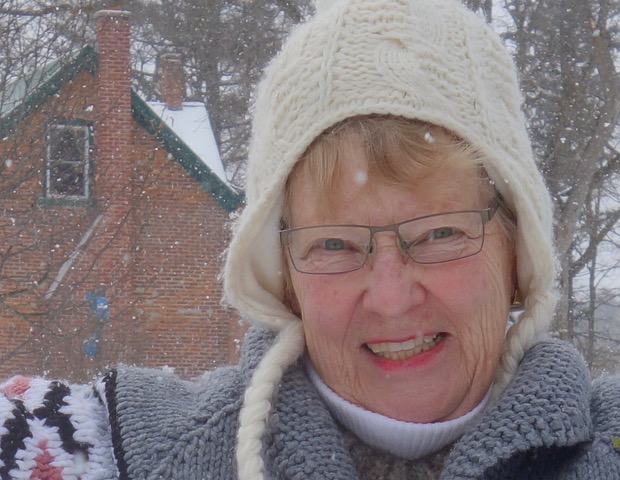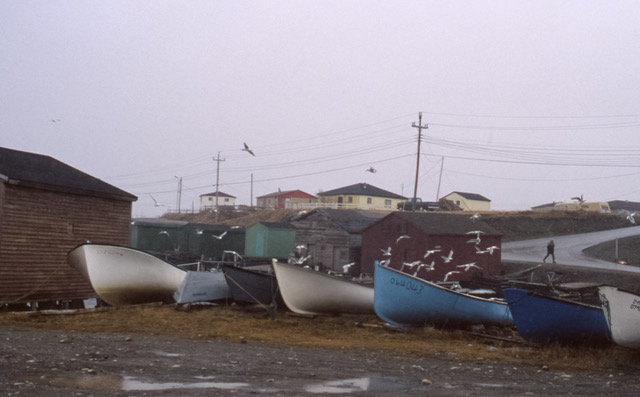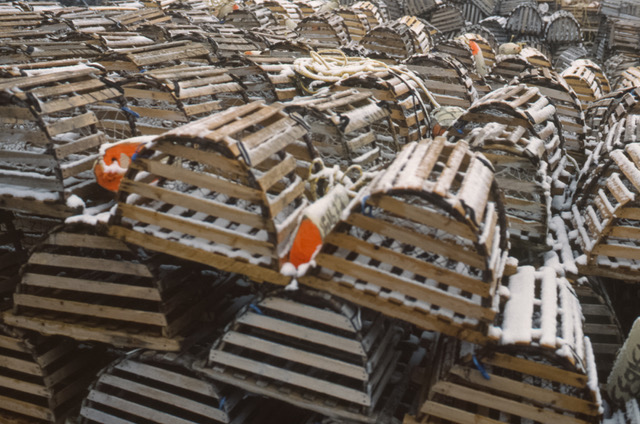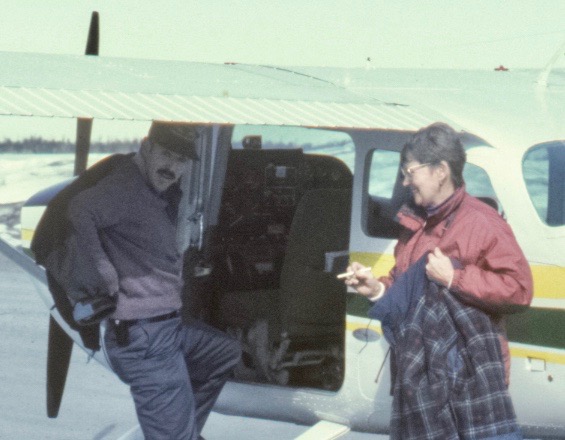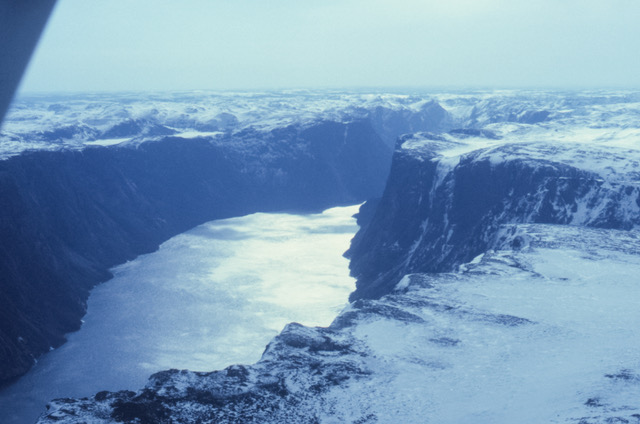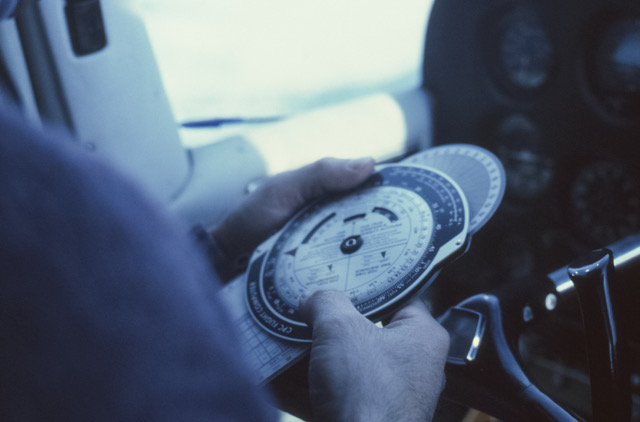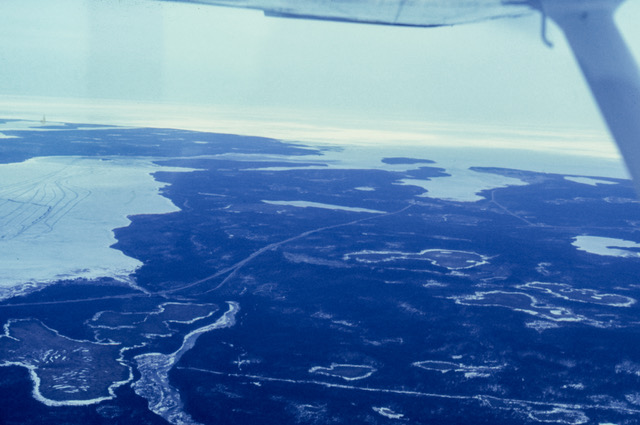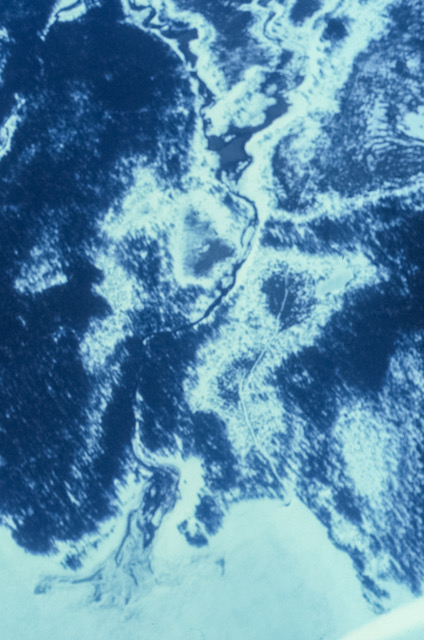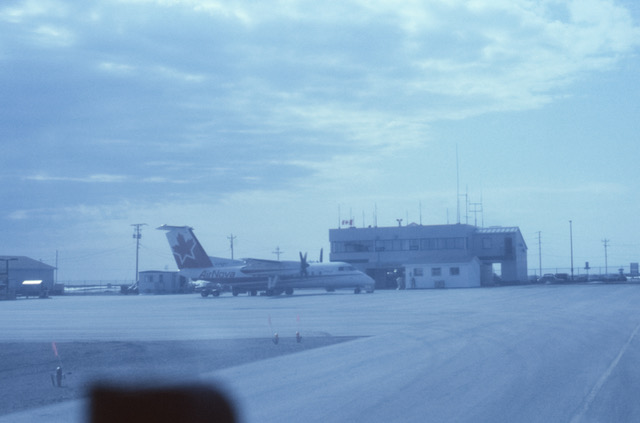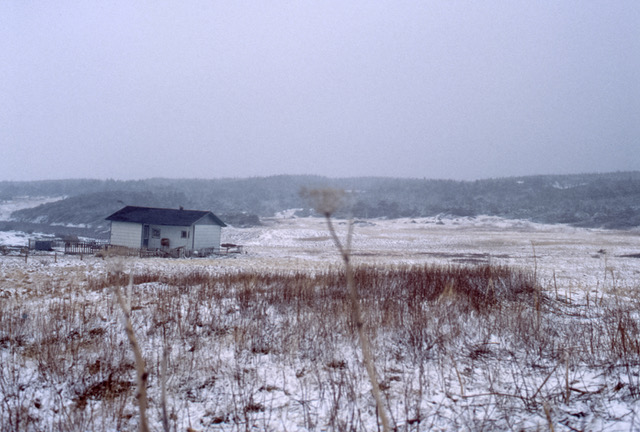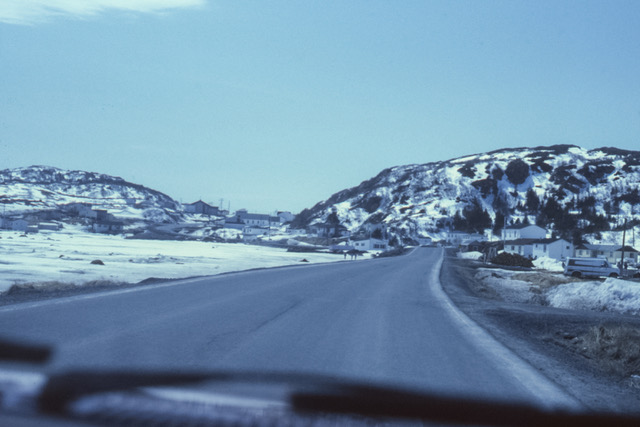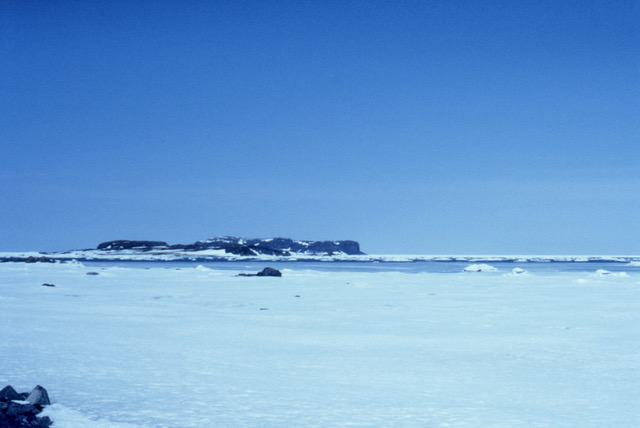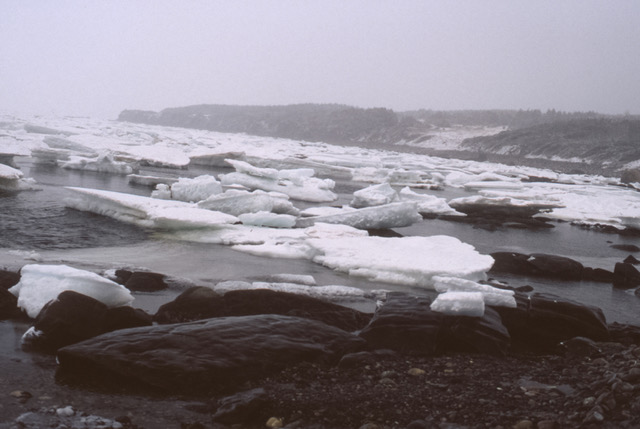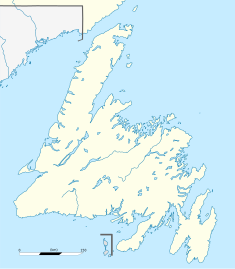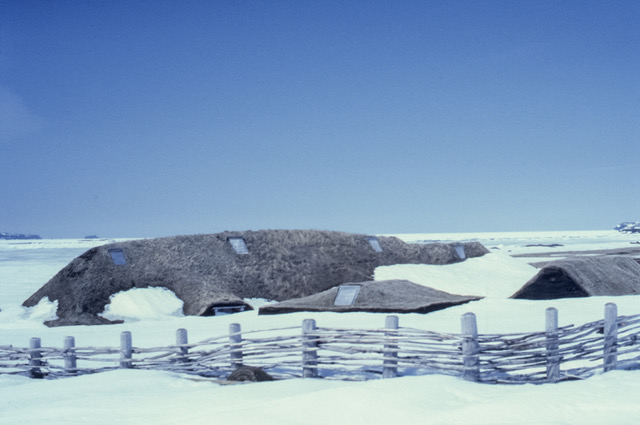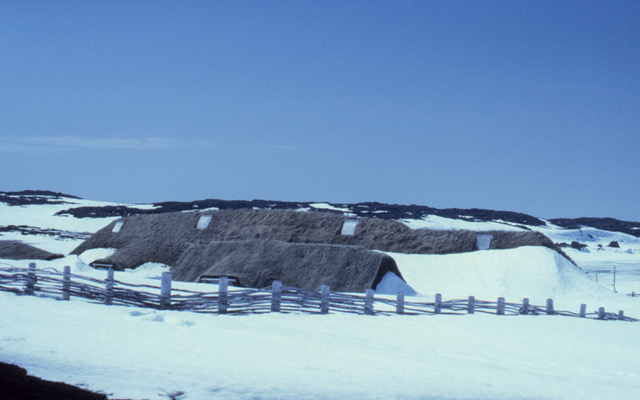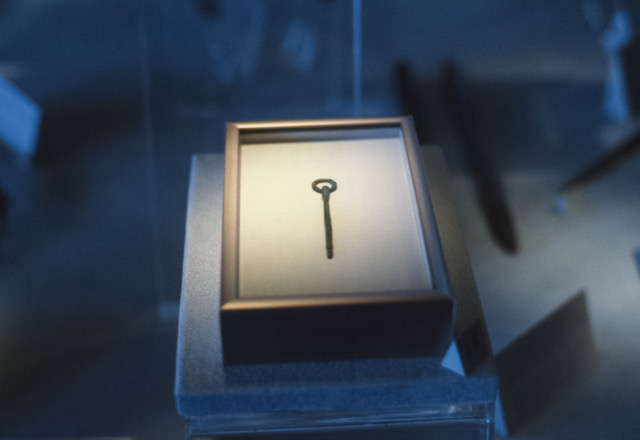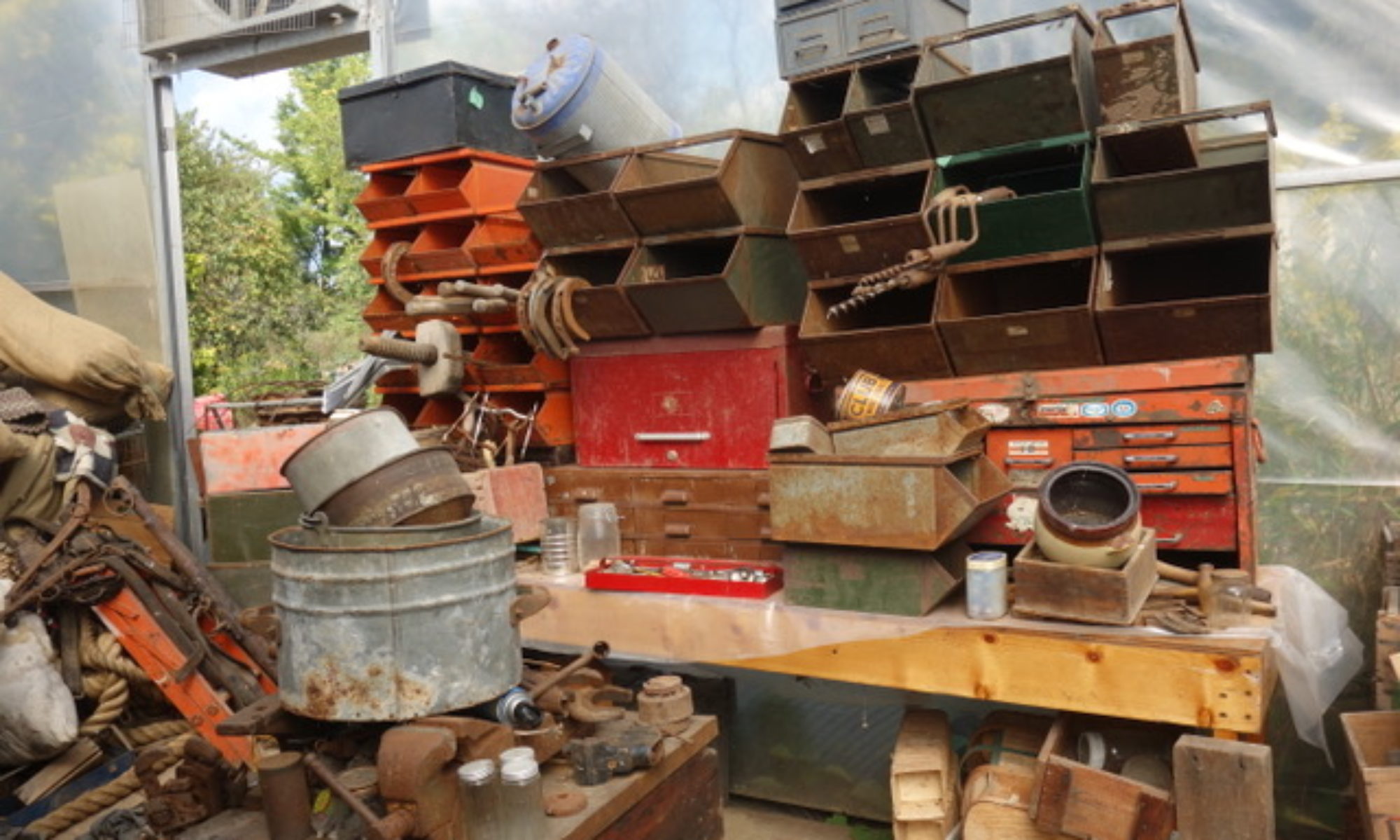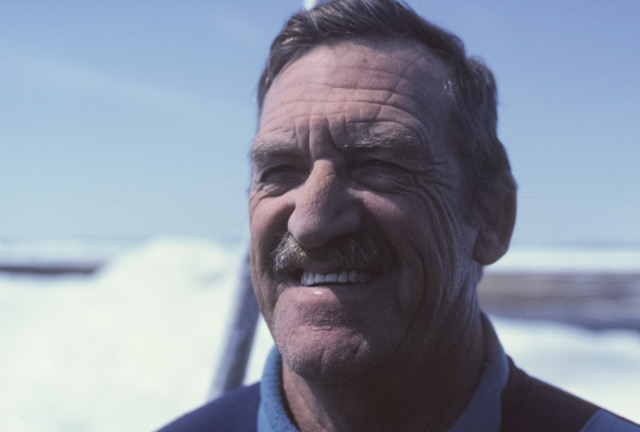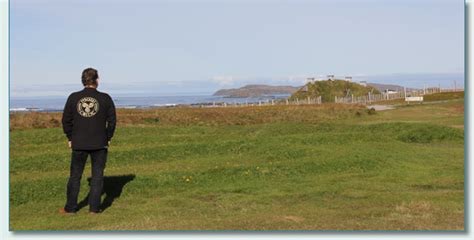FEAR… ” “ALAN, WE ARE GOING TO DIE.’
“Alan, we are going to die!”
“Close your eyes.”
“I can’t!”
“Just updrafts and downdrafts, Marjorie”
“We did not expect these headwinds.”
“Turn around…turn around.”
“The pilot knows what he is doing, Marjorie,”
“But all this gasoline! Drums loaded all around my seat.”
“Just don’t strike a match!”
“Alan, stop trying to be funny…I am scared.”
I dared not agree with Marjorie by saying so. But I was scared too. How did we get in this predicament? Thousands of feet in the air heading north up the west coast of Newfoundland. Great swaths ice and snow wrapped around bare and brutal rocky spots. Back home in Toronto it was the month of May, 1994, and the spring flowers were in full bloom. Here, high above Gros Morne Wilderness the lands mostly white punctured by shades of grey and which folded into the brutal black of bare rock. We had taken off from the nearly abandoned old US Air Force base at Stephenville. The only plane on the cracked tarmac where once fleets of shiny new Lancaster Bombers prepared for the cross Atlantic flight to Scotland during World War II. To say it was bleak was an understatement.
A day earlier, while having a coffee in Cornerbrook, I met our pilot. “Wouldn’t it be nice to drive up to L’Anse Aux Meadows, if only we had enough time.”
“I could fly you there tomorrow if you want…have a Cessna in an empty hanger at the old American base.”
“Really? I can pay your costs.”
“Good…Tomorrow at first light. I’ll get some extra gas.”
“Got room for two?”
“Your wife? Yes, we can squeeze her in.”
So much time has flown by that I have lost our pilots name. He was a gregarious fellow, that much I remember. Italian Canadian. And, somewhat daring, but I did not know that until we were airborne.
“That’s a place for Marjorie…”
“Are those five gallon cans of gas?”
“Need them for the return flight. Marjorie can fit between them and lean against the big one at her back.”
“Alan?…”
“Wrap that feather stuffed coat around you…could be a bit crafty. Still winter around these parts.”
I boosted Marjorie in before she could back out and make a run for it. There was no place to run anyway. The pilot pushed a starter and the propeller hiccuped a couple of times then whispered into life. I would like to say thundered. Hoped I could say thundered. But it whispered. Unsettling sound. Even with the passengers and loads of extra gas the Cessna danced across the old runway like a wounded butterfly. Then lifted and began to climb.
This great chasm that cuts into Newfoundland from the Strait of Belle Isle is the treasured UNESCO world Heritage site of Gros Morne. It was our basic point of reference before the Cessna headed north into the unknown “where the highway far below is our best guide” said our pilot adding “unless there is fog”. He did not elaborate. “No soft landing here,” Marjorie muttered.
“We’ll head for Gros Morne…easy point of reference. Cuts into Newfoundland like a giant bread knife.”
“Windy up here!”
“Guessed it might be.”
“Are we moving north…seems more up and down.”
“I’m scared, Alan, plane shakes so much.”
“Just a bad headwind, might have to fight it all the way to St. Anthony,” interjected the pilot who seemed to be holding the controls as hard as we were holding our seats. Then he released hold and grabbed something like a Ouija board.”
“What’s that thing in your hands?”
“Kind of calculator…points the way”
“Dependable?”
“Yes, but I use a road map as well…look down there you can see the highway.”
“What about fog?”
“Makes things a bit touchy, don’t you think?”
“Any places to land if we miss the airport…what is there north of St. Anthony?”
“Nothing all the way to the Arctic Circle…no place to land unless you fancy touching down on a iceberg…lots of them this time of year. Drift down from the Greenland ice sheet.”
“My wife is worried…scared, really. Assume you’ve done this trip many times.”
“Nope, first time.”
“Alan!”
“Just look down there, you can see the road…only road north.”
“I don’t want to look down.”
A few thousand feet below the road north to St. Anthony and L’Anse Aux Meadows was visible. Barely visible. The pilot glanced down regularly and adjusted his flight path so it lined up with the road. Beside him, in a pocket, was a CAA road map. No fog. No fog yet.
“Sorry that you’re wedged in so tightly with those gas drums,”
“Dangerous?”
“Not really unless something goes wrong. I tightened the spouts this morning.”
“But?”
“Don’t worry so much Marjorie. Enjoy the scenery.”
“What scenery…all I see is snow, ice and bare rock.”
“Look West…You might see a pod of whales coming down the Strait….some always there,” said the pilot.
About then I remember a comment he made back in Cornerbrook. “Sure, I can fly you up there…it will be a kind of adventure,” Yes, that’s what he said. He did not say “fly up there all the time” or “I took tourists there last summer” or “no problem”. Instead he used the word ‘adventure’. Did this mean he had never flown up before this moment.? Adventure?
“Alan, I am going to be sick!”
“There’s a tin can near your feet, throw up in that… ” We use the can on fishing trips.”
“Alan, the can is full of worms!”
“Where are we going?
“To L’Anse Aux Meadows…one of the most mysterious places on earth I am told.”
“Mysterious?”
“A Thousand years ago Vikings landed here…lived here for a few years…not long but long enough to build homes.”
“Why? This is a barren…”
“A thousand years ago the weather was warmer…climate had changed…ice melted along Greenland coast and in Iceland.”
“Sure looks bleak today, a thousand years later…”
“Marjorie, you know why the Vikings came here a thousand years ago?”
“No, don’t know and what’s more I don’t care.”
“They came for the trees. No wood in Greenland so a couple of 2x 4’s had high value…and pelts…and maybe wild grape wine or wild grape raisins.”
“When will we land? I hate this trip.”
“Soon. This was obviously not a teaching moment.”
Trying to distract Marjorie from her feeling we faced certain death was no easy task.
“Norse settlers immigrated to Iceland and then to the coast of Greenland. Warm enough for pigs, cattle, horses…even grain crops and vegetables. Stayed like that through 11th and 12th centuries…even longer. Norse settlers told stories and wrote these stories down…called sagas…”
“True stories or fiction?”
“Bit of both I think but always with a kernel of truth. The sagas told of
violent times way back in the tenth and eleventh centuries.”
“How did you come to know about them?”
“I was captivated by the book West Viking written by Farley Mowat… made those Norse sagas come to life in the 1960’s” Loved the book. Relived the sagas in my mine. Imagined the thrill of heading west into the unknown. Did Vikings settle in North America 500 years before Christopher Columbus? No evidence of that until….Well, let me put its way, For decades it was rumoured that Viking settlers had reached North America, created a village, stayed for a few years and then pulled out… but no one knew if that was true or just a story.”
“Do you mean we are wasting money and risking our lives on a story that may or may not be true.”
“No…”
“Then what?”
“About 1960 two archeologists, the Ingstads, figured the Norse – Viking settlement if it existed must have been at the northern tip
of Newfoundland. If the saga of Lief Erikson could be believed. So they began exploring the coastline below our airplane.”
“They discovered…”
“The word ‘discover’ is a tricky word. Implies that no other human being had known about the Norse…or at least the place where they might have settled.’
“The Ingstads asked people below us if they knew of any strange sites.”
“And?”
“And that is where George Decker comes into the story…He had known something was near his house all his life.
George Decker met the Ingstads and said to them that….”
“Something wrong up ahead, Alan. The airport is not there. Been moved. I was just starting my approach .. no airstrip. New one must be around here somewhere. Gas is getting low and the motor seems rough.”
“What will we do?”
“Not to worry, there it is over there. Moved it a few miles to get bigger prop planes in.”
“Motor is coughing.”
“She’s going to quit…but I can set her down. Hold on.”
And we bumped our way to sitting position on the airstrip ‘that is surrounded by a chain link fence to keep the moose out.”
“Here we are, I have a car coming for us …would you like to join us?”
“Sorry, can’t do that.”
“Nothing else to do around here…empty and bleak.”
“got to rebuild the motor, something wrong…got to spruce her up for our flight home. Get back here around 3 if you can.”
Hard to believe this was the first week of May. The airport was small and hard to find. While our pilot took his motor apart and laid out the pieces on the windy tarmac at St. Anthony, we were picked up by the winter custodian of L’anse Ajux Meadows. Bleak! Bleak! Bleak! I wondered how the Norse could ever live here then remembered that a thousand years ago this treeless landscape was densely forested and the open spaces must have been rich in sweet berries otherwise why would Leif Erikson call this vinland…land of wine?
“Alan, are you sure you have the right place?”
“Why?”
“So desolate…almost empty…a few lonely houses. No trees. Lobster traps and small fishing boats.”
The villages near L’Anse Aux Meadows are rather desolate places. No trees. Above the tree line. Newfoundlanders who live there make a living from the sea…lobster traps dropped from tiny fishing boats. But when we arrived the shores were so clogged with slabs of ice that no fishing could possibly be done. Tough place to live. It must have been totally different a thousand years ago else the Norse would not even have landed their long open boats with whole families and livestock aboard.
Vinland? Hardly believe that today.
“I know it’s bleak here now but trees flourished long ago. That was one reason for the Norse voyages…the search for lumber to take
back to their treeless Greenland communities.”
“Do the Norse still live along the shores of Greenland?”
“Not the Norse of ancient times. New people have moved in through. And more will come if global warming turns out to be true and the
ice retreats.”
“What happened to the ancient Norse people?”
“No one really knows for sure.”
“The earth got colder and colder for hundreds of years and the Norse were forgotten. By the 15th century the Greenlanders were forgotten. Another grand mystery.
Archeologists have dug up some of the old graves in Greenland and found deformed skeletons suggesting disease or inbreeding. Others comment on some blue eyed Inuit people suggesting assimilation. Bottom line is that they disappeared and the rumour of a North American Vinland seemed to be a legend.”
“I remember the stories of Eric the Red and Leif Erikson…”
“Wild men who travelled with equally wild women according to the sagas.”
“Lots of exaggeration….Fake News .”
“Eric the Red named Greenland in hopes that settlers would think the land was green when really the land was a treeless verge tucked in the shadow of mile high glaciers. Was naming this part of Newfoundland ‘Vinland’ the same kind of Fake News? Possibly. The notion of a land of milk and honey would attract settlers. What you see outside the car windows today is hardly that.”
The Northern tip of Newfoundland is desolate. A few fishing villages along the ocean shoreline. A totally empty interior.
“When will we get to L’Ans Aux Meadows? Must be a few buildings there with central heating and a cup of coffee?”
“Not sure about that, Marjorie, but maybe.”
“We are nearly there now?”
“No sign of any people…no houses…just a flat monotonous slightly rolling flat lane merging with the seashore”
“No, we are there,” said our host driver who looked after the site.
“But there is nothing here?”
“Look closely…real close.”
“Some bumps of sod…”
“That’s it…L’Ans Aux Meadows…the fabled Vinland that flourished for a few years a thousand years ago and was then forgotten
as was Greenland itself. This is it…Vinland..”
“So this L’Anse Aux Meadows…the Norse settlement in North America 500 years before Christopher Columbus made his discovery.”
“Is this some kind of bad joke?”
“There is nothing here … just us …almost the tallest figures in the whole landscape.”
“You risked our lives to get to this God forsaken corner of the world where no birds can sing.”
“What does L’Anse Aux Meadows mean anyway?”
“Arguments over the name but consensus is “Jellyfish Clove”. The English word ‘Meadows’ came to be used after French settlers left. Original word was
‘Meduses’ or Jellyfish. Other names? ‘Medee’s Cove’ named after the Greek god Medea.’ Let’s take the Jellyfish name…easier.
“What has that got to do with the Vikings?”
“Not a damn thing.”
See that long finger on the left. Right at the very tip…as har north as you can go in Newfoundland…is the site of L’Anse Aux Meadows. We flew up that western coast from near the bottom to the very top. It was an adventure. Worth the effort in m opinion. Not so in Marjorie’s opinion.
“What are those bumps?”
“Fake buildings identical to Norse sod roofed buildings of 1000 AD.”
“Who built them?”
“The Government of Canada…Parks Canada.”
“How are we sure the site is authentic?”
“Now that is an interesting tale. Let me introduce you to George Decker…He is as much a discoverer of this place as the archeologists.?”
“Hi, are you George Decker?”
“Seems to be my name around these parts, yes”
“Are you’THE GEORGE DECKER’ who showed the Ingstads the ancient Viking settlement?”
“Not quite that simple.”
“But you are given credit for…”
“They asked me if there were any old camps…any BUMPS that are unusual…
“And you said?”
“There’s an old Indian camp over at the Cove…think it was a campsite long ago…long before the Deckers got here.”
“And that old site is now the oldest European settlement in North America. One of the wonders of our world.”
“I don’t know if I would go that far.”
“World Heritage site…recognized as such.”
“How did the Ingstads confirm this had been Leif Erikson’s home for a few years?”
“The Ingstads spent 7 years carefully excavating the bumps…turned out to be ruins of sod houses…found a lot of small things that made the place world famous.”
“Like what?”
“Like that big pin and the spindle whorl and some bits of bog iron…you could hold all these things in the palm of your hand but each one was proof of Norse presence here a thousand years ago.”
THE EVIDENCE: Was this an ancient boat repair station or the real VINLAND? THE DEBATE GOES ON AND ON.
1) THE PIN is the same kind of pin that Norsemen used to hold their clothing together. The same pins are found in Norwegian museums.
2) THE SPINDLE WHORL is that small round stone with a hole in its centre. That little piece of stone was evidence that L’Anse Aux Meadows was not just a temporary Norse campsite. The Spindle Whorl indicated they planned to stay here for some time. Why? Because a spindle whorl is used to spin wool into yarn. Then the yarn is made into clothing. The Spindle Whorl indicated that the Norse brought sheep with them in their ships. Sheep indicated a permanent settlement was planned. The sagas state that Leif brought cattle including a very angry bull. The intention was to create a community. A farm. In addition to the 135 men there were 15 women which seems to be confirmed by the discovery of the Spindle Whorl. Women used Spindle Whorls to make the yarn. Men did not do that.
3) BITS OF BOG IRON. One small depression turned out to be a smelting oven for the manufacture of iron from a precipitate chemical called Bog iron found in swamps. Some bits of iron and broken rivets were found in the excavation. These iron fragments did two things. First they established that the site was Viking and that boat building or repair was once a function of the site. Second, according to recent thinking L’Anse Aux Meadows was really a boat repair station and not the fabled Vinland which has yet to be discovered and may never be discovered.
AND SO OUR ADVENTURE ENDED.
LET’S GET OUT OF HERE:
“Alan, couldn’t we take a bus back to Cornerbrook?”
“No bus service that I know about.”
“I just want to get home and see the kids again.”
“Look over there, the Cessna has its cowling back on and all those torque wrenches are packed away.”
“Not comforting.”
“We will have a stiff tailwind all the way back to Cornerbrook…get there fast.”
“Not comforting.”
“We have seen L’Anse Aux Meadows …Jellyfish Cove…in all its lonely splendour.
“Not comforting.”
“And those big tanks of gas are now emptied into the gas tank.”
“Not comforting.”
“Any final comments?”
“Alan, this was a foolish trip…”
“But unforgettable?”
“Yes, unforgettable, FOR SURE.
ALAN SKEOCH
FEB. 20, 2018
recalling an adventure
A YEAR LATER:
A year later Marjorie, Kevin, Andrew, Tara (the coonhound) and I drove from Mississauga to L’anse Aux Meadows. Took a good part of the summer to get there. The place looked different in summer. Replica sod houses seemed livable. Reminders of the long winters remained however for there were
several icebergs grounded just outside Jellyfish Cove.
Beneath our feet, however, the meadow was carpeted with blueberries. Blueberry wine was also sold in Newfoundland. Vinland.
Berries close to the ground. Wine can be made from any fruit…perhaps these. A thousand years ago when the land was warmer it is just possible that there were more berries to be converted into wine. But that is just speculation. Perhaps Leif Ericsson used the skill of an advertising executive to name Vinland just as was done when glacier covered Greenland was named.
VINLAND FOUND: THE BUMP IN THE GROUND WAS 1,000 YEARS OLD
They found Vinland. They found the place where Norse settlers lived a thousand years ago. Not just Norse adventurers. Norse settlers. There is a big difference between the two. Adventurers came first. Settlers came later. No longer a mystery for they found proof of a settlement when they unearthed part of needle and a small stone with a hole in it. The stone was a spindle whorl which the Norse used to spin wool. Let me correct that statement. The spindle whorl was used by ‘women’ to spin wool. Women were present. The sagas say that Thorfin Karlsefni, along with 135 men and 15 women along with their animals and three ships spent several years at L’Anse aux Meadows.
Women! This was a home settlement rather than a camp. IT WAS REAL! (Or most authorities think it is real.)
REPLICA OF THE SITE AT L’ANSE AUX MEADOWS (LEFT).
“Marjorie, look here, there is George Decker staring at the BUMPS in the ground that turned out to be what many believe is the fabled VINLAND.” (ABOVE RIGHT)

“AND the bumps in the ground lasted 1,000 years.”
Replica sod house above.
WANT TO READ MORE? VINLAND…THE SAGAS?
|
|
|
|
The earliest and most complete information we have about Vinland the Good is found in two sagas, Greenlanders’ Saga and The Saga of Erik the Red which tell of the Viking discovery of North America. The two accounts were written independently, though both tell of things which took place in the early 11th century that were passed down by word of mouth in Greenland and Iceland until they were written down in the 13th century in Iceland. Both give general descriptions of the native peoples the Vikings met, relative sailing distances, and landscape features which help us determine the location of Vinland. But the two versions are also contradictory in a number of ways, and while they provide much information about the new lands, they do not conclusively resolve the question, “where was Vinland?”
Excerpt from one of the two sagas that describe Vinland.
They afterward determined to establish themselves there for the winter, and they accordingly built a large house. There was no lack of salmon there either in the river or in the lake, and larger salmon than they had ever seen before. The country thereabouts seemed to be possessed of such good qualities that cattle would need no fodder there during the winters. There was no frost there in the winters, and the grass withered but little. The days and nights there were of more nearly equal length than in Greenland or Iceland. On the shortest day of winter, the sun was up between “eykarstad” and “dagmalastad.” When they had completed their house, Leif said to his companions, “I propose now to divide our company into two groups, and to set about an exploration of the country. One-half of our party shall remain at home at the house, while the other half shall investigate the land; and they must not go beyond a point from which they can return home the same evening, and are not to separate [from each other]. Thus they did for a time. Leif, himself, by turns joined the exploring party, or remained behind at the house. Leif was a large a powerful man, and of a most imposing bearing¬a man of sagacity, and a very just man in all things.
American historical documents, 1000-1904 : with introductions and notes. New York : P.F. Collier, c1910. The Harvard classics v. 43.
|
|
